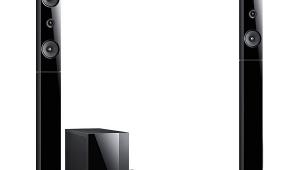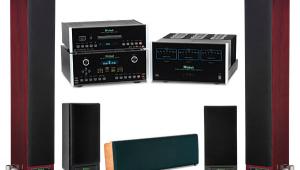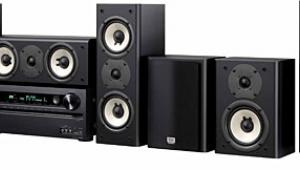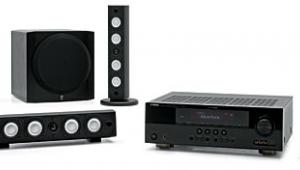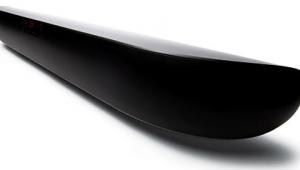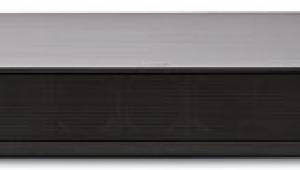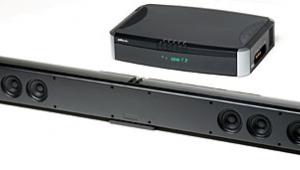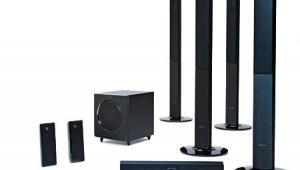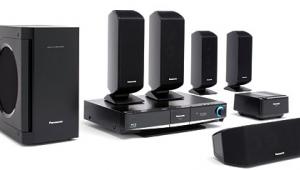Good lord I love this system! Love to demo it actually. I've always drooled over that beautifull green glow. Think ill use this space to comment on how badass the Hi-End issue was! A great issue that i read cover to cover twice, and this review was my favorite review. Only thing is how in the name of mutiple drivers could you not show a pic with the grills off? I wanna see all those drivers! You even had space to do it cause you showed the speaker set on two different pages. All is forgiven though. Let me fetch my drool rag.
Dreaming the Not-Impossible Dream Page 4
The sense of three- dimensional, sound-bubble coherence was complete and effortless, with the surround speakers obviously contributing to the field but not making their physical presence apparent, thanks to what is clearly a superbly designed, smoothly dispersive tweeter.
I’m not going to go through a laundry list of explosion-rich movies auditioned to demonstrate this powerful system’s obvious ability to play incredibly loud, go remarkably deep, produce enormous dynamic swings, and keep a tight grip on the proceedings throughout, but trust me, in terms of those tasks, and especially in terms of transparency and three-dimensionality, I haven’t heard a more capable system, at least not in my room.
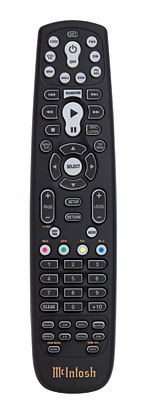 Here, if the McIntosh system errs in any direction, it would be toward a leanness in the lower midrange/upper midbass, producing a slight lack of warmth that emphasizes, in a piano, for instance, the percussive transient of the hammer on the strings as opposed to the resulting sounding-board resonance, giving the instrument a somewhat lean overall texture. Likewise, an acoustic guitar would be more about the percussive strum than the resulting woody resonance.
Here, if the McIntosh system errs in any direction, it would be toward a leanness in the lower midrange/upper midbass, producing a slight lack of warmth that emphasizes, in a piano, for instance, the percussive transient of the hammer on the strings as opposed to the resulting sounding-board resonance, giving the instrument a somewhat lean overall texture. Likewise, an acoustic guitar would be more about the percussive strum than the resulting woody resonance.
Implementing Audyssey room correction in my space with other systems usually reduces an attractive, well-controlled, narrow-Q, low-frequency excess, but running Audyssey this time seemed to actually fill in the missing warmth. However, the trade-off was a loss of the system’s incredible transparency, crystalline clarity, and subjective phase coherence. Therefore, I mostly left it off.
The Musical Component
Some movie enthusiasts probably would spend $34,000 just to be blown out of their seats by a capable assemblage like this, both for its sonic performance and its high bling factor. Even after a month, I found looking at it almost as pleasurable as listening to it.
Given its heritage, you’d hope this system would impress more with music than with cinematic sound effects, and regardless of your sonic tastes, I think you’d find the musical proceedings startlingly excellent—even if your preferred sound is somewhat more Town Car-ish.
Did you watch The Grammys this year? The show concluded with one of the greatest Grammy performances I’ve seen. At the piano, Paul McCartney, accompanied by his trio and a sumptuous string section, performed a shortened version of the album-closing medley from Abbey Road, beginning with “Golden Slumbers.” When it came time for “The End,” McCartney stepped away from the piano and joined, guitar in hand, bandmates Rusty Anderson and Brian Ray, who were met on stage by Bruce Springsteen, a remarkably fit-looking Joe Walsh, and Dave Grohl. They traded squealing mini guitar solos choreographed by a finger- pointing McCartney, while monster drummer Abe Laboriel, Jr. pounded the spit out of his drum kit.

Have you ever sat in a large venue fitted with a state-of-the-art sound system and heard and felt the power of a well-miked drum kit—particularly the kick drum—actually pressurize an enormous space? This was the first time I experienced that sensation at home.
I cranked it up pretty loud (thankfully, my wife was at the Westminster Kennel Club Dog Show that night). The intensity of the compressed slap and release combined with the bass drum’s power-body slam and as perfectly rendered a crunchy snare and crackling cymbal as you’re likely to ever hear from a television show, absolutely sent me over the sonic moon!
I liked it so much I watched it repeatedly, measuring the SPL peaks in excess of 110 decibels; I could have played and enjoyed it even louder but that would have been insane. Luckily, I recorded the show on a high-definition D-VHS recorder (another great failed format I happily adopted). But when I watched it again on my reference system after this one had been packed up and shipped away, it turned into a sonic nightmare!

Don’t get me wrong. My reference system is very good, and costs more than $15,000. And the Grammy segment sounded OK, but it was more Town Car-squishy compared to the McIntosh system’s dynamic thrust, rhythmic certainty, and incredible transparency. The entire body-slam sensation was gone! The sense of a single, bristling-with-energy, organic, transient wallop transmitted with each pound of the kick drum was completely missing. Turning up the volume only amplified the disappointment—not that this aspect of musical reproduction is the most important. It’s not. It’s just important.
Higher-Resolution Audio
Viewed on an 100-inch Stewart screen through a JVC DLA-HD750 projector, I can’t honestly say I saw a noticeable improvement in picture quality over my inexpensive Blu-ray Disc player. Perhaps the MVP891 measures better, and perhaps in a direct A/B test it might look better (or maybe I’m just not as sensitive to it), but the viewing experience did not produce a wow factor similar to the listening one. However, the MVP891’s sonic performance was something else.
CD after CD, comparisons between the HDMI digital output with D/A conversion performed by the MX121 versus that of the player’s own digital-to-analog converters run balanced to the control center demonstrated the player’s sonic superiority. Not that the MX121 wasn’t accomplished as well; it just wasn’t as refined.
The MX121’s onboard DACs produced somewhat darker and thicker sound. By comparison, the MVP891’s rendering of familiar material produced an airier, more dimensional soundstage upon which were more subtly drawn images, particularly in terms of transient delicacy and transparency.

These are differences perhaps only a dedicated audiophile might pick up or even care about, but they were consistently heard and appreciated. Surprisingly, the MVP891 was able to play an old, defective Mobile Fidelity gold CD of Traffic’s eponymous second album that, due to flaking, had up until then been unplayable on other machines I’d tried.
Space doesn’t permit more detail here, other than to say that the MVP891 was a superb-sounding digital-audio player on CD via its balanced outputs, as well as on DVD-Audio discs through its single-ended, 7.1-channel, analog outputs. Via the balanced output, Neil Young’s 192 kHz/24-bit, two-channel, Archive DVD-Audio disc sounded better than I’ve ever heard, and if you prefer the balanced output and don’t mind a two-channel mixdown, the player will automatically perform it.
As for SACD, I have two copies of Beck’s brilliantly recorded Sea Changes, so I put one in the MVP891 and one in my Sony SACD player and did direct A/B testing. While the Sony was somewhat softer, smoother, and mellower, and the MVP891 punchier and better defined, I can’t say I preferred one to the other. They just sounded different. I happily sat through the MVP891’s playback of Analogue Productions’ 5.1-channel SACD of Pink Floyd’s Wish You Were Here, and other than nearly hitting the ceiling when, at one point, a voice mixed to the right-rear channel surprises the listener, the sound had all of the smooth flow I expect from DSD.
Conclusions
I hope you’ll get an opportunity to hear this McIntosh dream system under reasonably good circumstances—whether or not you can afford it. I can’t help but think you’d wish you could, although perhaps not if you’re the Town-Car type.
Before the system was fully disassembled, I substituted my reference Sonics speakers. These metal-cone and -dome speakers could hardly be characterized as being soft or romantic, yet compared to the XR100 loudspeaker system, they were. Still, despite their tonal honesty, the XR100 assemblage was neither bright nor hard sounding—unless the recording was.
At $16,500, this system, with its five well-engineered, surprisingly compact, and attractively finished speakers, actually strikes me as a good value, considering what audiophile speakers sell for these days.
I’d probably put the MC8207 amp in the high-value category, too, even at its $6,000 price point. It’s a rock-solid-sounding, high-power/high-performance, impeccably American-made amplifier that adds pride of ownership and bling factors that can’t be quantified. And McIntosh gear is notorious for holding value better than most.
If you want a player just to watch movies on DVD and Blu-ray Disc, I’m not sure you need to spend $5,500 for the MVP891 universal player, however. On the other hand, if digital-audio playback is important to you, the MVP891 is also a superior-sounding CD, DVD-Audio, and SACD player.
As for the MX121 control center, it lacks certain expected amenities like an HD tuner, satellite radio ports, a headphone jack, and front-mounted A/V inputs, so if those are important to you, you’ll have to look elsewhere.
Otherwise, although some of its functionality resembles that of the far less expensive Marantz upon which it is party based, it’s audio and build quality are more than a few significant steps up, especially in terms of subjective dynamics and signal-to-noise ratio. So why hesitate? What’s a few more dollars when you’re assembling a dream system, especially if you’re only dreaming?
- Log in or register to post comments


Hi, Michael,
Thanks for a compelling review (as ever).
Can you tell me whether the pre/pro can output 11.2, for simultaneous wides and heights in a "full" Audyssey DSX setup? D & M's Denon currently has the only piece of equipment I know that can output 11.x, as opposed to just 9.x.
Thanks, again for a great review...back in the early '90s, I saw/heard a demo with a Vidikron PJ (and Faroudja line-doubler) and a full McIntosh system, including speakers. I'll never forget it; it's what compelled me to dive more deeply into HT--albeit at a more modest investment level (although I did grab a Vidikron Crystal One back in the day).
Will
P.S I agree with Jarod--let's see those "spider eyes!"

I enjoyed the read and have been specifically waiting for reviews of the mx121 & mc8207. But I was really hoping for more description of the amplifier and how it compares to others in and around it's price range. Two paragraphs in how many pages?!?
Obviously it's a top pick so that gives it credibility--but compared to what? What equipment does the reviewer feel to be a direct competitor. Is it worth more 6 times the cost over an emotiva with a similar specs?
It makes me wonder if there there was just too much great equipment to be under review for one article?

I really enjoy reading your articles. McIntosh certainly produces some very good equipment. I have some questions about the MX121.
You mention the functional similarities between the MX121 and the Marantz AV7005. Would you please comment on the sonic differences between the two processors (especially wrt movie dialog/soundtracks)?
Does the increase in price reflect an equal increase in the sonic performance?
Does the MX121 processor have balanced circuitry throughout the signal path (or is the balanced input just a connector as I understand it is on the AV7005).
Thanks.

Well not quite for the masses perhaps. But one can dream. Great review are some fan static gear. Having a Mac integrated amp that I find to be awesome, would go with these Mac AV units in a heartbeat for home theater.
Always thought McIntosh could not really build great speakers just because their amps are so very great. When finally had a chance to audition a pair used for the back surround in this system. Incredible.
Expensive yes,but as is said, "The Quality Is Remembered Long After The Price Is Forgotten".
Really enjoyed the background history of Radio Days.

I was reminded whilst reading this press release of the recent Lexicon/Oppo brouhaha.
Do you really expect us to believe that a prepro the same size as a Marantz Av7005, from the holding company of the AV7005, with a remote that is the same as the AV7005, with the same connections as an AV7005, and the same menu, and the same features, is not in fact an AV7005 with a cooler faceplate?
Since the 'reviewer' has an AV7005, could he resolve my cynicism and pop the lid on both and show us the innards?

If you'd spent any time reading my reviews here or in Stereophile you'd know that I'm hardly one of those all too common elsewhere "publicist/reviewers." So rather than calling you a cynic, I'll just say you're misinformed and move on.
It was easy to see just from looking into the top cover openings that these units did not look the same inside and I don't think you read all that carefully if you use the phrase "same connections".
Only the video connections were the same and in the same location and that's because it was the same video board, which McIntosh admitted to me upfront. And yes, the two units share the same basic operating system and it's a very good one, but the two were not identical in every way.
I drive a Saab 9-3 Turbo-X XWD automobile. It's a fantastic, fast car. It uses the same RADIO head unit that GM uses in Chevies, but otherwise there's no performance connection i can assure you. This is similar. So McIntosh uses a very good video board also used in the 7005. So what?
The Marantz 7005 is a better value for sure. I own one. But the McIntosh is a better sounding and more highly refined product. McIntosh maintained control of what it does best, which is in the analog signal processing and pre-amplification and the overall design of signal paths, layouts, etc. not to mention the overall construction quality that's certainly more important to some than it is to others.

McIntosh has always been over priced and frankly I have never been a fan of their equipment or clunky design vocabulary. And then there is the sound,…ehhh…eeesh does this junk come with earplugs?
Across the board if you took the same money and bought a collection of brands you could put together a far superior system. Look to Bryston (a 9BSST2) or Classe for amplification. Look to Oppo for a truly well respected universal player (how about a good comparison test BDP-95 with the Mac?)
Any number of speaker choices Dynaudio, Monitor, Focal, Revel , etc, etc., etc would offer better sound.
For me, McIntosh is an old retail brand that made its name when there was less competition. It’s an expensive choice for those who do not know any better but have heard the brand name mentioned by others of the unwashed.
Today there are so many other choices and for the same investment the selection is so much more exciting
For processors choose Anthem, Lexicon or even Onkyo would be better choices because you’re correct in saying the processor space is moving so fast. With Onkyo you could replace the proc every couple of years as formats evolve. By the way this will continue to happen with new disk and diplay technologies continue a’pace. The same goes for DACs, constant improvement, spend less, upgrade often.
On the other hand you can spend a fortune on this big old clunky bullet proof McIntosh gear and be stuck in the 50’s forever.

Really ? A dream system article with GRILL ON speaker pics ? Really? Let's see some interior pics of the amp and pre-amp while we're at it. Those are the things that we'd all like to see in our dream system , build quality and design topology.

Hello Michael,
I am looking for a processor to upgrade my Anthem MRX 700,
This MX 121 is interesting in deed, and i dont know why but the D2V it has been always my goal to achieve...now i'm considering this unit, how do they compare?
Some dealers said to me that the MX 121 is better sound wise and better scalable. Some other said to me the D2V is clear the winner and better build...
Could you please give me a hint on this?
Miguel Casellas

Nice. Marantz sourced parts. I may as well just buy Marantz and save thousands.

Here's a different take. I love reading old Hi-Fi reviews and I just read this one late in 2020. This is the stuff I crave when I'm perusing old copies of audio rags. Mike made we "feel" something that I first remember when I was about 12-years old starting my audio discovery that has continued on (I'm 61 now). I love to read about great gear bringing great joy to the listener. I'd say this review does that for the reader. Fantastic review of something truly special and at a price for the whole some singular components actually cost in 2020.

Well, at least for me, it is possible to dream about surviving a car accident and not take it personally. Because it is just a dream.

Because their amps are so exceptional, I've always believed that McIntosh cannot actually produce excellent speakers said lawn service norman ok. When given the opportunity to finally try out a pair used for the system's rear surround. Incredible.

Taking the time and genuine work to make a staggering article… yet what may I have the decision to say… I misuse a ton and never figure out a methodology for directing oversee total anything. growthingly

Development costs are considerable in this category, and in this rapidly evolving water damage control environment, a product may be nearing, if not already obsolete, by the time it is introduced to the market.

What equipment does the reviewer feel to be a direct competitor. Is it worth more 6 times the cost over an emotiva with a similar specs? See: https://wellingtonretainingwall.co.nz/

It's not really impossible. Dumpster Rental Cedar City
